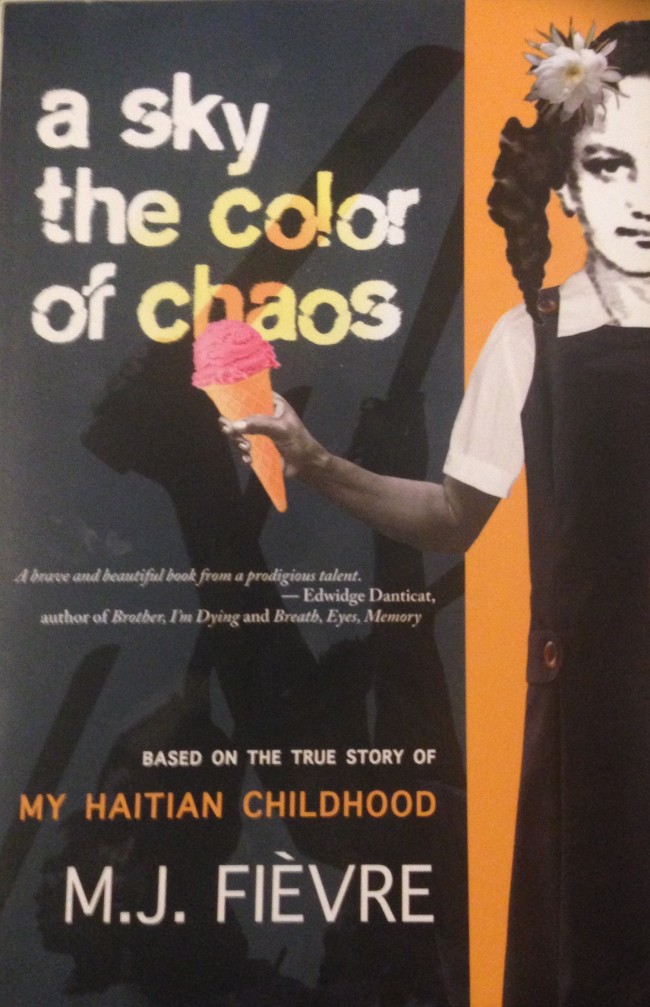I do not believe there’s a certain age at which a writer is suddenly prepared to write a memoir, though I sometimes wish the criteria were this easy, this concrete. There are other metrics that could be used: the amount of major events, the degree of trauma or enlightenment, the critical distance the writer has established from the narrative. By that final item, I mean, how close can the writer approach the material before becoming overwhelmed by it or simply unable to draw out its significance. If only this were just a function of time. And if only we could quantify that perfect balance between sentimentality and ambivalence, when the first threatens to make the narrative so saccharine that it’s barely palatable and the second can just make even the most engaging prose flatline.
However, the power of M.J. Fièvre’s A Sky the Color of Chaos is its ambivalence. The memoir follows Fièvre’s experiences growing up during Haiti’s chaotic 80s and 90s, as well as the complicated relationship between the author and her father. It’s easy to approach this book as viewing these two themes as metaphors for each other: Haiti’s tumultuous political climate as a larger representation. Certainly, a lesser writer would do just this. But Fièvre allows herself to acknowledge the similarities between her home situation and her homeland: the way violence and trauma are so pervasive and routine that the narrator becomes almost numb to it; the way Fièvre manages to always keep a hair away from danger; the way love can become tangled with shame and fear. A Sky the Color of Chaos is a careful, lyrical balancing act that manages to veer away from overt symbolism, from resolution.
It would be minimizing to understand A Sky the Color of Chaos as a study of Fièvre’s interactions with tragedy. The book gives us a protagonist that is precocious and unflinching. We’re taken through her encounters with young men, with religion, with adolescence. And, perhaps most poignantly, with her own violence and rage. After purchasing a knife outside of school in order to protect herself, Fièvre writes:
I was the master of my destiny–independent, separate from and unreliant upon anyone else. Safe and warm inside. All I had to do in case of danger was pull out the knife and death would swallow the zenglendo–flimsy and slick.
I waved one last time at Papa before I entered the school. I wished he could see I was not the same girl he’d dropped off minutes before. I was a new me–vengeful, cautious, ready to strike. The rage inside me was still boiling, but I could do something about it. I was reborn – more dangerous, ready to get in the face of peril and spit.
But the knife’s affect on our narrator, or even the implications of purchasing it, isn’t quite so easy to parse. It is in these situations where Fièvre’s ambivalence gives the emotions of the memoir their power and veers away from cliché. “I never knew that kind of meanness in me,” Fièvre considers after driving her new knife through a wooden locker door at basketball practice. “Things inside me moved toward something I didn’t know, and couldn’t come back from.” A Sky the Color of Chaos is a study of the things that ultimately comprise and shape our humanity, and how often it is that we can express that we have been changed without necessarily being able to say how. There are situations that, regardless of our distance from them, will never be accessible with full clarity. This is ultimately what A Sky the Color of Chaos is about. Time can heal wounds, but we’ll still struggle forever to explain the hurt.
While Fièvre has a vivid, poignant grasp on the world of her book, as well as a discerning hand that allows for the ubiquity of violence to never veer into “disaster porn,” some of her stylistic choices bog down the clean, quick read. For instance, one of Fièvre’s more puzzling decisions is to implement footnotes. They often are no more than a sentence or two in length, explaining the cultural significance of a comment or grounding a name-drop in a little history. I could not find a footnote that couldn’t have simply been woven into the narrative, and it is a disservice to the engrossing prose to have it disrupted. But perhaps it is equally an indictment of readers who require these footnotes in lieu of the motivation to seek out the context themselves.
However, one of the finer uses of this strategy can be found in Junot Diaz’s The Brief Wondrous Life of Oscar Wao, where the footnotes serve to explain the history while still existing in the unique voice of the protagonist. They possess his humor and his bitterness. They feel more intentional, while Fièvre’s sometimes feel as if they were added in by a third party to help along the average American reader. There is only one example of a footnote in A Sky the Color of Chaos that has any of M.J. Fièvre’s personality: an aside after Fièvre reveals that she collects human bones. It reads: “Real human skeletons are available for purchase at local hospitals. Creepy, I know.”
It’s a rare glimpse of Fièvre’s humor and reflexivity, a side of her character that is refreshing amidst the heaviness of her situation. Especially in a book so centered on ambivalence, in a narrative tugged about by so many strong emotions, we could benefit from Fièvre having a little more fun.




